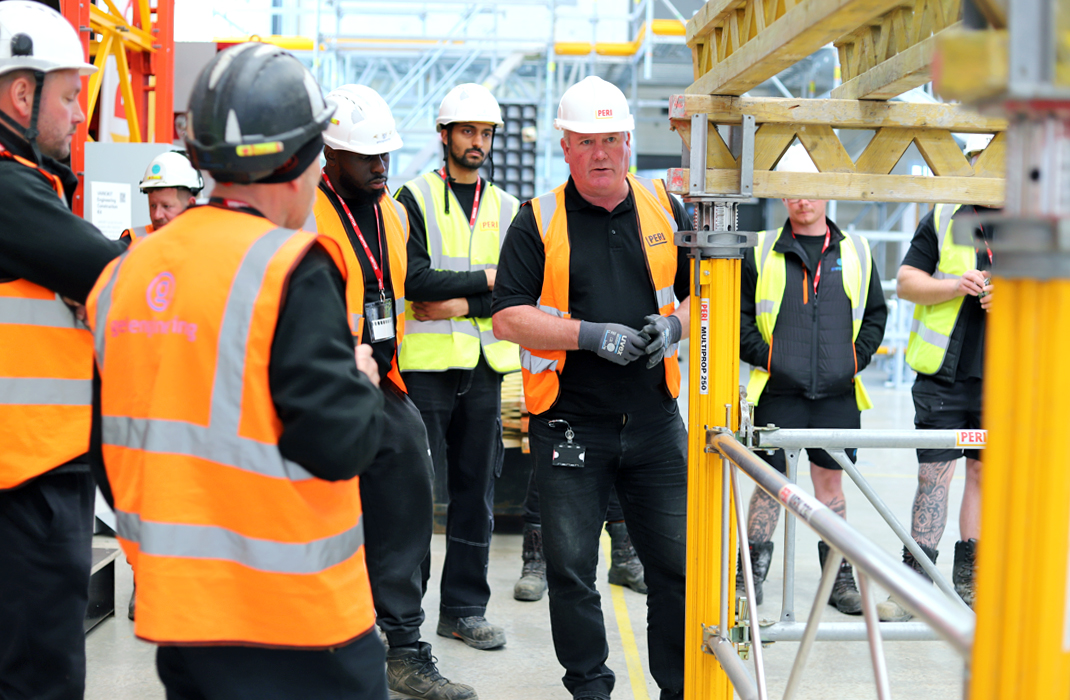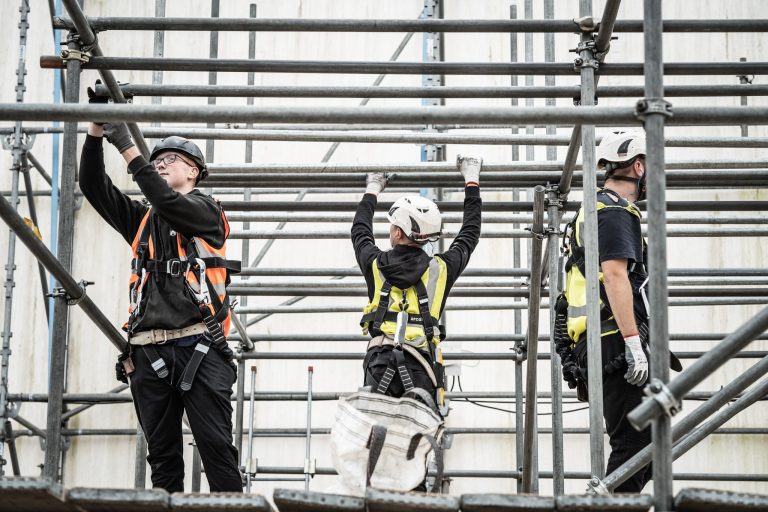 Over the past year, Hall has trained and upskilled more than 120 individuals through PERI UK’s accredited programmes, which can be delivered both on-site and at the company’s training and exhibition facility in Brentwood, Essex.
Ian Hayes, Managing Director of PERI UK, said: “We’re incredibly proud of Terry and this well-deserved recognition. His determination has enhanced our service and set a new benchmark for safety and professionalism across the concrete structures industry.”
The CONSTRUCT Day awards celebrate excellence within the in-situ concrete sector, recognising individuals and teams who make significant contributions to safety, innovation, and skills development.
Over the past year, Hall has trained and upskilled more than 120 individuals through PERI UK’s accredited programmes, which can be delivered both on-site and at the company’s training and exhibition facility in Brentwood, Essex.
Ian Hayes, Managing Director of PERI UK, said: “We’re incredibly proud of Terry and this well-deserved recognition. His determination has enhanced our service and set a new benchmark for safety and professionalism across the concrete structures industry.”
The CONSTRUCT Day awards celebrate excellence within the in-situ concrete sector, recognising individuals and teams who make significant contributions to safety, innovation, and skills development. PERI UK’s Terry Hall recognised as ‘Unsung Hero’ for driving formwork safety reform
 Over the past year, Hall has trained and upskilled more than 120 individuals through PERI UK’s accredited programmes, which can be delivered both on-site and at the company’s training and exhibition facility in Brentwood, Essex.
Ian Hayes, Managing Director of PERI UK, said: “We’re incredibly proud of Terry and this well-deserved recognition. His determination has enhanced our service and set a new benchmark for safety and professionalism across the concrete structures industry.”
The CONSTRUCT Day awards celebrate excellence within the in-situ concrete sector, recognising individuals and teams who make significant contributions to safety, innovation, and skills development.
Over the past year, Hall has trained and upskilled more than 120 individuals through PERI UK’s accredited programmes, which can be delivered both on-site and at the company’s training and exhibition facility in Brentwood, Essex.
Ian Hayes, Managing Director of PERI UK, said: “We’re incredibly proud of Terry and this well-deserved recognition. His determination has enhanced our service and set a new benchmark for safety and professionalism across the concrete structures industry.”
The CONSTRUCT Day awards celebrate excellence within the in-situ concrete sector, recognising individuals and teams who make significant contributions to safety, innovation, and skills development. Scaffolders urged to tighten safety as climate change brings fiercer storms
 Common shortcuts that extreme weather can expose include mixing components from different manufacturers, failing to follow assembly guidelines, inadequate checks of mudsill anchorage or scaffold Ties, and using damaged components, such as cracked boards or rusted elements. Poor safety culture, where workers aren’t encouraged to report concerns, compounds these problems.
Planning and design failures present particular risks. Strength and stability calculations must be completed for any scaffolding that doesn’t conform to recognised standard configurations. Complex designs require competent persons to draw up assembly, use and dismantling plans, with documentation available to all workers on the project.
Foundation-level checks are frequently overlooked, according to McCarron Coates. Ground conditions, particularly areas with drains or rain-softened soil, may not support the weight of scaffolding structures. Similarly, attaching sheeting or netting to scaffolds not designed for these additions creates instability. Even when designs allow for sheeting, it must be fitted to become sacrificial in high winds, preventing suction forces from toppling the entire structure.
The firm emphasises that compliance with NASC’s TG20 guidance is essential for structures to withstand severe weather. The guidance enables contractors to determine maximum safe heights and proper configurations for scaffolding, sheeting and debris netting.
Post-storm inspections are equally critical. Following each weather event, competent persons must reinspect scaffolding structures, complete written reports, and implement corrective actions immediately.
Common shortcuts that extreme weather can expose include mixing components from different manufacturers, failing to follow assembly guidelines, inadequate checks of mudsill anchorage or scaffold Ties, and using damaged components, such as cracked boards or rusted elements. Poor safety culture, where workers aren’t encouraged to report concerns, compounds these problems.
Planning and design failures present particular risks. Strength and stability calculations must be completed for any scaffolding that doesn’t conform to recognised standard configurations. Complex designs require competent persons to draw up assembly, use and dismantling plans, with documentation available to all workers on the project.
Foundation-level checks are frequently overlooked, according to McCarron Coates. Ground conditions, particularly areas with drains or rain-softened soil, may not support the weight of scaffolding structures. Similarly, attaching sheeting or netting to scaffolds not designed for these additions creates instability. Even when designs allow for sheeting, it must be fitted to become sacrificial in high winds, preventing suction forces from toppling the entire structure.
The firm emphasises that compliance with NASC’s TG20 guidance is essential for structures to withstand severe weather. The guidance enables contractors to determine maximum safe heights and proper configurations for scaffolding, sheeting and debris netting.
Post-storm inspections are equally critical. Following each weather event, competent persons must reinspect scaffolding structures, complete written reports, and implement corrective actions immediately. Connolly Scaffolding unveils major new Salford base as part of multi-million-pound expansion
 “We’re in a great location to cover the North West, London, Bristol, Nottingham, and even Cornwall. The new premises give our team room to grow and the facilities to deliver a more efficient, professional service.”
Connolly Scaffolding also operates an in-house training centre, with plans to host the Mayor of Salford later this month for an official visit. A professional photoshoot and drone footage release are planned for late November to showcase the site.
“We’re in a great location to cover the North West, London, Bristol, Nottingham, and even Cornwall. The new premises give our team room to grow and the facilities to deliver a more efficient, professional service.”
Connolly Scaffolding also operates an in-house training centre, with plans to host the Mayor of Salford later this month for an official visit. A professional photoshoot and drone footage release are planned for late November to showcase the site. Surge in construction apprenticeships as CITB support drives 61% rise
URTIM powers Turkey’s first floating gas platform
Turkey has taken a major step towards energy independence with the completion of its first floating natural gas production platform, the Osman Gazi.
At the heart of this landmark project lies a custom-engineered scaffolding system developed by URTIM Formwork & Scaffolding Systems, designed to meet the demanding conditions of offshore construction in the Black Sea.
The Osman Gazi Floating Natural Gas Production, Storage and Regasification Unit (FSRU) has been built to process, store, and transfer up to 10 million cubic metres of natural gas per day — enough to supply energy to around eight million households.
Developed with a 20-year operational lifespan, the platform represents a major boost to Turkey’s domestic energy infrastructure. Its conversion and assembly were completed at the shipyard’s dry dock facilities in record time.
Measuring 298.5 metres long, 56 metres wide and 29.5 metres deep, the vessel underwent a rapid transformation into a floating production system, involving more than 1,000 tonnes of steelwork, 900 tonnes of pipe installation and 8,000 tonnes of module removal within just eight months.
Engineering at sea
Offshore environments pose unique challenges, including exposure to wind, vibration, corrosion, and limited accessibility.
To meet these, URTIM developed a tailored scaffolding solution for the platform’s helideck section, rising 42 metres high with a 15-metre cantilever span. The design incorporated high load-bearing connections, rigid frames, and corrosion-resistant materials to ensure both durability and safety.
URTIM said the system became a vital element of the build, enabling safe and efficient work throughout construction.
With more than 45 years of experience and a portfolio of over 4,000 completed projects across 70 countries, URTIM is one of Turkey’s leading scaffolding and formwork specialists.
The Osman Gazi project demonstrates how domestic engineering expertise can deliver world-class results. Every stage, from design to production and installation was completed using local resources.
URTIM’s system not only supported the platform’s construction but also set a new benchmark for safety, accessibility, and performance in offshore environments.
CISRS announces suite of new safety and inspection courses
New and updated training programmes
Mobile Aluminium Towers A new Mobile Aluminium Tower Training for Scaffolders course has been developed to give scaffolders a full understanding of Health and Safety legislation and best practice when working with prefabricated aluminium access towers. It covers safe erection, alteration, and dismantling using both the Through-the-Trap (3T) and Advanced Guardrail (AGR) methods, both endorsed by the HSE. Delegates will also study tower stability, component inspection, and environmental hazards, including wind and unstable ground. The course is being piloted now, with a full rollout due in November 2025. Advanced Scaffolding Inspection The revised Advanced Scaffolding Inspection course, launching this November, incorporates updates from TG20, TG30, and current BS EN standards. It adds greater focus on digital inspection methods, photographic reporting, and the inspection of complex system scaffolds. Expanded practical exercises will help candidates improve real-world judgement and decision-making. Fall Arrest Equipment Inspection A new Fall Arrest Equipment Inspection course provides scaffolders and supervisors with essential knowledge to ensure fall protection systems meet SG4, SG16, and legal requirements. Delegates will learn to inspect and maintain harnesses, lanyards, and other safety gear, along with rescue planning and examples of self-rescue and assisted recovery. The course will be rolled out in November 2025 following pilot testing. Installation and Testing of Scaffold Anchorage Systems This course teaches safe installation and testing of scaffold anchors in line with BS 8539 and NASC guidance TG4, TG20, and TG30. It covers determining tie duties, performing pull tests, interpreting results, and applying best practice for anchor installation. Environmental considerations such as dust, vibration, and noise are also addressed. The course will launch in November 2025. System Scaffolding Product Training Scheme Launching in early 2026, the System Scaffolding Product Training Scheme will give scaffolders cross-brand proficiency in popular system types, including Cup, Wedge, Rosette, and Pocket systems. It aims to ensure consistent safety and competence across multiple scaffold manufacturers. CISRS said the new suite of programmes reflects its ongoing commitment to training excellence and technical integrity. Each will go through the new Quality Assurance process before national delivery. More details and local training centre information can be found at cisrs.org.uk/training-centres.House-building recovery delayed until 2029, industry warns
Growth forecasts downgraded
The CPA has downgraded its growth forecasts for the construction industry, cutting expected output from 1.9% to 1.1% this year and from 3.7% to 2.8% for 2026. It blamed a sluggish summer for the decline in construction activity and said the recovery expected earlier in the year had failed to materialise. With tax rises expected in the 26 November budget, the CPA warned that many households and investors are delaying major spending decisions, further limiting demand. Noble Francis, CPA’s economics director, warned that more construction firms are likely to go under if the government does not intervene. “Construction has already lost more than 11,000 firms since early 2023,” he said. “Given current low levels of house-building and home improvement, we expect insolvencies to accelerate in 2026. A positive, time-limited stimulus for house-building demand is urgently needed—particularly for first-time buyers—before insolvencies further damage skills and capacity throughout the supply chain.”Industry voices concern
CPA chair Adam Turk, who is also chief executive of insulation manufacturer Siderise, said the sector was bracing for worsening job losses and skills shortages unless action is taken. “This is not scaremongering but an honest reflection of what is happening on the ground,” Mr Turk said. “We’ve already seen house-building collapse in London, and while we’re encouraged by recent government intervention there, that help is needed nationwide.” He added that many firms had invested heavily in staff and resources since the 2024 election, anticipating a housing recovery. “Without a market boost, much of that investment could be in vain,” he warned.Staht secures largest ever distribution deal with Leach’s

Avontus to host free webinars on digital scaffold management this November
- Track scaffold requests and progress from build to dismantle
- Digitise inspections, handovers, and safety documentation, including RAMS
- Use approval workflows for transparent, auditable records
- Work offline in the field and sync when reconnected
- 4 November 2025, 10:00 AM AWST
- 5 November 2025, 11:00 AM GMT
- 6 November 2025, 9:00 AM PST
Scaff25 announces global line-up of industry leaders for Sydney conference















